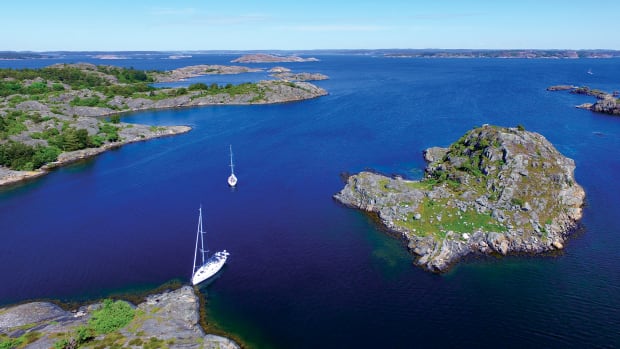
With 2,000 miles of coastline, 270,000 islands and seemingly countless bays and inlets, Sweden is truly a sailor’s paradise. One of the top sailing destinations here is the archipelago just outside the country’s second largest city Gothenburg (locally known as Göteborg), on the west coast, near where the North Sea meets the Baltic.
Even though it’s second in both notoriety and size to Sweden’s capital, Stockholm, Gothenburg’s port is the largest harbor in Scandinavia due to its strategic location on the eastern shore of the Kattegat, the shallow strait located between Sweden and Denmark’s Jutland Peninsula. This maritime heritage is symbolized by the Sjömanstornet—a 230ft memorial tower for sailors standing near the center of downtown on the banks of the Göta River and crowned by 60ft sculpture of a woman gazing out to sea. At the foot of Sjömanstornet are inscribed the names of 690 Swedish sailors who lost their lives during the First World War and the names of the ships they perished on. Not far from Sjömanstornet, is another seafaring treasure, Maritiman—a fascinating waterfront museum with a large selection of historic Swedish military and commercial vessels.
For those sailors looking to unwind a bit—either at the end of a passage or before casting off lines for their charter the way we did—Gothenburg is fun and easy to explore with foot and bike paths that run along the banks of the Göta River. You’ll find many wonderful well-maintained historic buildings here, including the classic and gorgeous Gothenburg Central Station, which is rife with small shops and eateries. Centrally located next to the train station is the historic Hotel Eggers, which one of the oldest and most elegant hotels in Sweden, dating back to 1859. In keeping with the maritime theme, Tyska Bron Havsbar is a very popular restaurant situated on a barge in the city’s main canal that has excellent food and atmosphere.
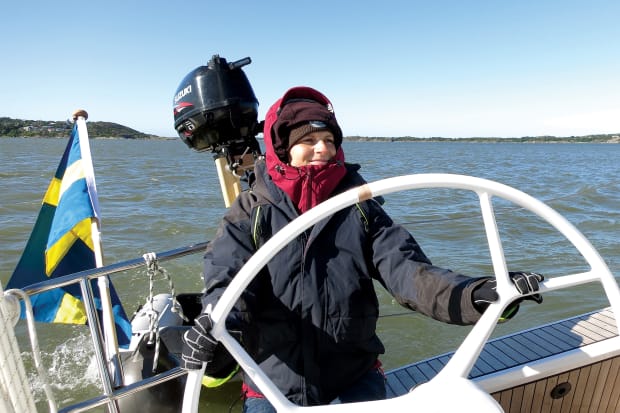
For the charter my crew and I had planned, we would be setting sail on a boat from Yachtcharter Göteborg (yachtchartersweden.se), which has a great fleet of new Bavaria monohulls, as well as a number of other models. The owners are very knowledgeable about sailing the region and the boats well equipped. The charter base is a short taxi ride from downtown. However, you’ll want to provision in the city center where you’ll find a number of large grocery stores.
From the base, it’s about four miles to the mouth of the Göta River, where it flows out into the open waters of the Kattegat. There are so many harbors, coves, islands and wonderful little Swedish hamlets to explore along the coast to the south and north, it makes sense to do some research and have a fairly concrete sail plan to get the most out of this trip.
The islands in this region are called “skerries,” and the skerries south of the mouth of the river are a little more wooded and developed, whereas, north one finds generally more barren rock and wild natural landscape with fewer people. Also, there’s much more to explore in the north. You could even sail all the way to Norway and back in a week or two if you really wanted to put in the miles, something that is not as crazy as it might sound. In mid-summer, the days are 18 hours long and nights are really just a prolonged dusk. In other words, you can get a lot done in a week-long charter.
Winds are variable, so be prepared for anything, and given all the island and fjords, expect significant wind shifts. A great little gadget I found for accessing the latest weather forecasts was a portable Wi-Fi hotspot called Travelwifi, a device that allows you to automatically connect to cellular carriers around the globe without a local sim card. A good source of local weather information is the Swedish Meteorological and Hydrological Institute’s Marine and Coastal Weather site, which provides forecasts in both Swedish and English.
Our first day out, aboard our well-maintained 2021 Bavaria Cruiser 37 we headed north to the island of Dyrön, 32 miles from Gothenburg. There are some low bridges connecting larger islands, so be sure to check your mast height against the charts. Again, there are a lot of islands to explore here. Most of them are barren rock, and very few offer good anchoring. For this reason, most boats tie bow-in when they go ashore, using the steel rings that can be found on countless rocks in this part of the world for that purpose. Most local boats carry rear anchors and ladders on their bows making the process that much easier. If you are nervous about rock mooring, traditional mooring balls can be found in some of the more popular spots, and a few anchorages even have sandy bottoms with good holding. All of this data is clearly marked on both paper and digital charts, including the Navionics software our boat came equipped with, so it’s pretty easy to plan.
Before hitting the port at Dyrön, we did a wonderful lunch stop at tiny Kärrsön Island, a short distance to the east. The island has a great hike to an old windmill that took me through a gorgeous old sea farm where I spooked a herd of wild deer. This is a very typical kind of experience you’ll find on these small islands. There’s usually only a couple of houses, few if any people and, more often than not, a dock or a beach where you can land your dinghy. If you like to explore and adventure, there is plenty of it here.
Similarly, on the larger, more popular islands, you’ll often find historic fishing villages painted in all those crazy colors that are typical here is Sweden, with of course the iconic Swedish red being the predominant color. Interesting fact: the “official” name of this paint color is Falun Red, a name that originated with the Falun copper mine in central Sweden, which dates back to the 9th century and is now a UNESCO World Heritage site. For years it was the largest copper mine in Europe, but it ran out of copper ore in 1687, at which point the owners needed to come up with a new way of making the mine profitable. Eventually, they hit on the idea of manufacturing red paint out of the piles of red-tinged iron-rich tailings still laying around. The red color is essentially iron rust.
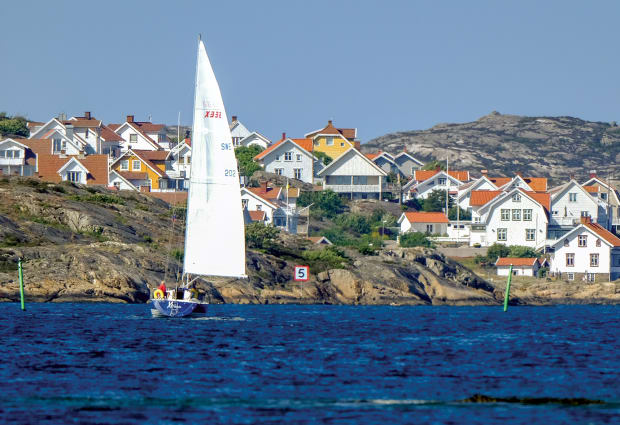
On Dyrön, we docked our boat at the island’s southern harbor, where we ran into a delightful family from Gothenburg with two kids and a toddler, all on their summer holiday sailing around the islands. When I stopped and chatted with them, I soon learned they had only recently purchased their boat with little or no experience and taught themselves to sail watching YouTube videos. Pretty amazing considering how technical the sailing is in these waters. Clearly, in this part of the world, sailing is in the blood.
The next morning, a storm blew in bringing torrential rain and strong winds, so we decided to lay low and explore Dyrön. The island has a wonderful three-hour coastal nature walk that circles the island, dipping in and out of forests, little coves and sandy beaches. On the other side of the island is another small harbor and a small village. There’s also a nice little miniature golf course that helped us while away our lay day.
The morning after that, the rain stopped, but it was still blowing hard, forcing us to spring off the dock. As expected, we had a very spirited sail north to the island of Lyr, where we tied up to a mooring ball in Bäckevik Bay on the island’s southeast coast. We had taken the inland passage to the east of Tjörn, to give us some shelter, which turned out to be a great choice as it gave us our first up-and-close experience dealing with hundreds of tiny islands, submerged rocks and tight passages that you find in these waters.
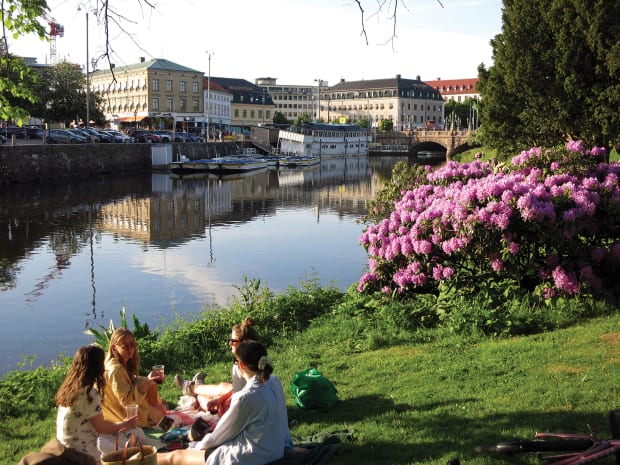
A word to the wise: it can be easy to hit bottom here and many do, especially charter boats. Not only that, it’s mostly rock, so hitting bottom almost always means boat damage or worse. If you want to avoid this costly (and potentially dangerous) embarrassment, the rule up here is: follow the channel markers and not your GPS.
As for Bäckevik Bay, we had a pretty quiet time there, making it the ideal charter anchorage. I caught a couple mackerel for dinner, we hiked for a bit and hung out at a beautiful sheltered sandy beach in the midsummer sunshine. Nice!
Our next destination was the island of Härmanö, home to Gullholmen, a beautiful historic fishing village town with tiny colorful houses all crammed together along the water. The island also has amazing and extensive hiking trails that bring you through rolling meadows, barren coastlines, picturesque wetlands and tiny forests. Another word of warning though: the trails here are not very well marked, making it easy to get lost. Be sure to bring sturdy shoes, food, water, sunscreen—and a GPS.
By now we had reached the halfway point of our charter, and it was time to start heading back to Gothenburg. For this part of the trip, the wind having come down a bit, we chose to snake our way through the islands on the exposed side of Tjörn. We’d heard there was a fantastic narrow fjord at Kirkesund that leads you through some fantastic rock formations and decided to give it a try, starting out with a good steady 12 knots on our beam, that shifted from beam to aft and forward and made for a wonderful day’s sail.
In addition to being as beautiful as advertised—with historic fishing villages seemingly everywhere you looked—Kirkesund fjord is also as narrow: so narrow we eventually decided to drop sails and motor for a while to be sure and stay out of the way of the many oncoming sailors we encountered. As I said, Sweden is a maritime nation. The people here really love to sail! Another thing I like about Swedish sailors is the way so many of them sail such modest boats. It reminds me of back when I kept a boat in Baltimore and so many of the other members of the yacht club I belonged to also had boats with lots of character.
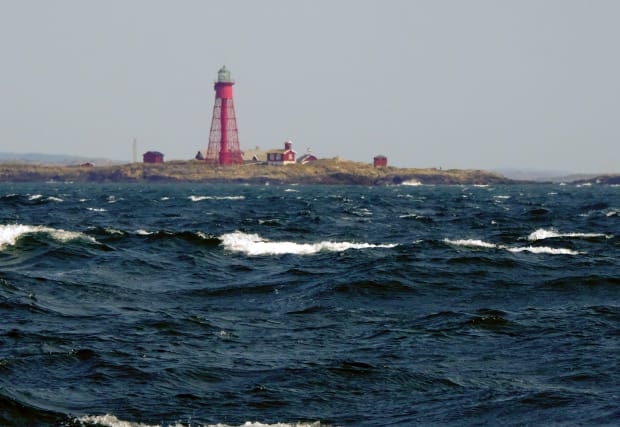
As the day progressed, our wind also started to die, and we decided to take the boat out into open waters of the Kattegat in search of more breeze. We also wanted to check out Pater Noster Lighthouse, about three miles off the coast. Built in 1868, it’s a beautifully unique, red, cast-iron skeletal 105ft light. I figured if I played my cards right, we’d only have to make a couple of quick tacks to get out and back to our destination that day: the harbor at Marstrand. Something I didn’t account for, though, was just how much wind we’d find offshore, not to mention the swells. We did eventually make it to the light and back, but it was a wild ride.
Marstrand was by far the most touristy place we visited. It’s home to Carlsten Fortress, a national landmark built in the mid 17th century and expanded over the years, with most of the work being done by prisoners incarcerated there. A tour of the fortress is as must do, as is a tour of the town. However, in many ways the best thing about Marstrand is its many excellent restaurants. One we enjoyed very much was Lasse Majas Krog, which is right on the waterfront and offers a wonderful seafood-inspired menu and great outdoor seating.
From Marstrand it was back to Gothenburg, where we returned the boat and set out for a few more days exploring by car. Among the places we visited was historic Anfasteröd Gårdsvik, on the east side of the biggest island of Sweden’s west coast, Orust, a spot where we’d hoped to pay a call during our charter, but couldn’t due to time constraints.

A former seaside farm run by fourth-generation descendants of the original family that settled there, the resort uses renewable energy, sources organic and local ingredients and has restored and uses many of the farm’s traditional buildings. We stayed in the home of the farm’s original blacksmith, a small but accommodating red wooden cottage on the water. The resort also has a number of great nature trails that lead along the coast, as well as kayaks, canoes and small motor skiffs for exploring some of the other nearby islands.
There’s even a cute little sauna located at the end of one of the resort’s docks. The idea is you get nice and hot and then dive in the water. This was probably one of my biggest challenges I faced on this trip, as I’m not a fan of cold water, and Sweden’s seas are in the 50s in June. But hey, the hardy Swedes love the water and love to swim, and well, it’s all part of the experience.
Photos by Michaela Urban








